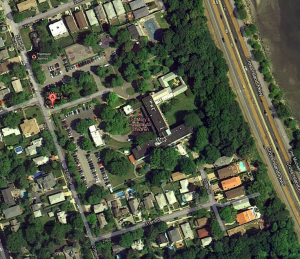Opponent’s attempt to stop construction declared moot. St. Mary’s Hospital for Children operates a 97-bed children’s hospital on an eight-acre campus at 29-01 216th Street in Bayside, Queens. The hospital building was built in the 1950s. In 2006, St. Mary’s sought to add a five-story, 90,000 sq.ft. addition to the eastern side of the hospital. In October 2008, St. Mary’s sought a determination from the Department of Buildings confirming that the site was permitted a maximum floor area ratio (FAR) of 1.0. Buildings denied the request, stating that the proposed addition needed to comply with a 1973 amendment to the zoning resolution restricting community facilities like St. Mary’s to a maximum FAR of 0.5. The amendment included an exception clause indicating that the amendment “shall not apply to buildings for which plans were filed with the Department of Buildings prior to November 15, 1972 including any subsequent amendments thereof.” On October 20, 2010, Buildings reconsidered, approving the request and allowing an FAR of 1.0 because the hospital was built prior to November 15, 1972.
In August 2010, Weeks Woodlands Association, Inc., a local advocacy group, filed an article 78 petition for injunctive relief to prevent any construction or issuance of bonds to finance the construction, and requested a restraining order to halt construction. Weeks Woodlands argued that the addition would exceed the site’s permitted FAR of 0.5. According to Weeks Woodlands, the 1973 amendment’s exception clause only applied to buildings in “the approval pipeline on November 15, 1972,” and not to projects proposed to be built 40 years later. St. Mary’s responded that the addition’s plans submitted to Buildings constituted a “subsequent amendment” under the zoning text because the addition was a modification within the scope of the project as shown in the hospital’s original plans, which were filed in the 1950s.
In January 2011, the lower court denied the preliminary injunction, finding that Weeks Woodlands failed to establish a likelihood of success with respect to their claim that the exception clause did not apply to the addition. The court held that a plain language reading of the 1973 amendment indicated that the exception clause applied to all buildings whose plans were filed prior to November 15, 1972, whether such buildings had been completed at that time or were still in construction.
In March 2011, Weeks Woodlands appealed the lower court’s denial of the preliminary injunction to the Appellate Division, First Department (New York County). Meanwhile, St. Mary’s continued building the addition.
In a split 3-2 decision issued on May 31, 2012, the First Department dismissed the appeal, finding it moot. A party seeking to halt construction must move for such relief at each level of the litigation. The appellate court found that, in this case, Weeks Woodlands failed to file a separate preliminary injunction directly with the First Department while the appeal was pending. Given the advanced stage of construction work on the project, which included completed foundation walls, a steel superstructure, and duct work, the majority found that Weeks Woodlands was “complicit in the project’s having reached its present advanced stage.” As a result, the appeal had become moot and therefore had to be dismissed.
In dissent, Justice James M. Catterson wrote that Weeks Woodlands’ original request for injunctive relief with the lower court should have been sufficient to prevent the appeal from becoming moot. The original request for a preliminary injunction with the lower court put St. Mary’s on notice of Weeks Woodlands’ desire to pause construction while litigation was pending. Justice Catterson wrote that the lower court erred in denying the preliminary injunction because the lower court erroneously construed the zoning resolution. According to Justice Catterson, the reference to “subsequent amendments” in the 1973 amendment limited the scope of the exception clause to projects which had started prior to November 15, 1972 and were still “in the works” awaiting final inspection and certificates of occupancy. As a result, the exception clause should not include plans for an addition filed with Buildings in 2010, more than a half-century after St. Mary’s original plans had been filed.
In response to the dissent, the majority noted that they “would have adopted the dissent’s cogent analysis of the zoning issue if [they] were to reach the merits.”
Weeks Woodlands Association v. Dormitory Authority of the State of New York, 95 A.D.3d 747 (1st Dep’t May 31, 2012) (Albert K. Butzel, for Weeks Woodlands Association; Karen Binder, for Dormitory Authority and St. Mary’s).


